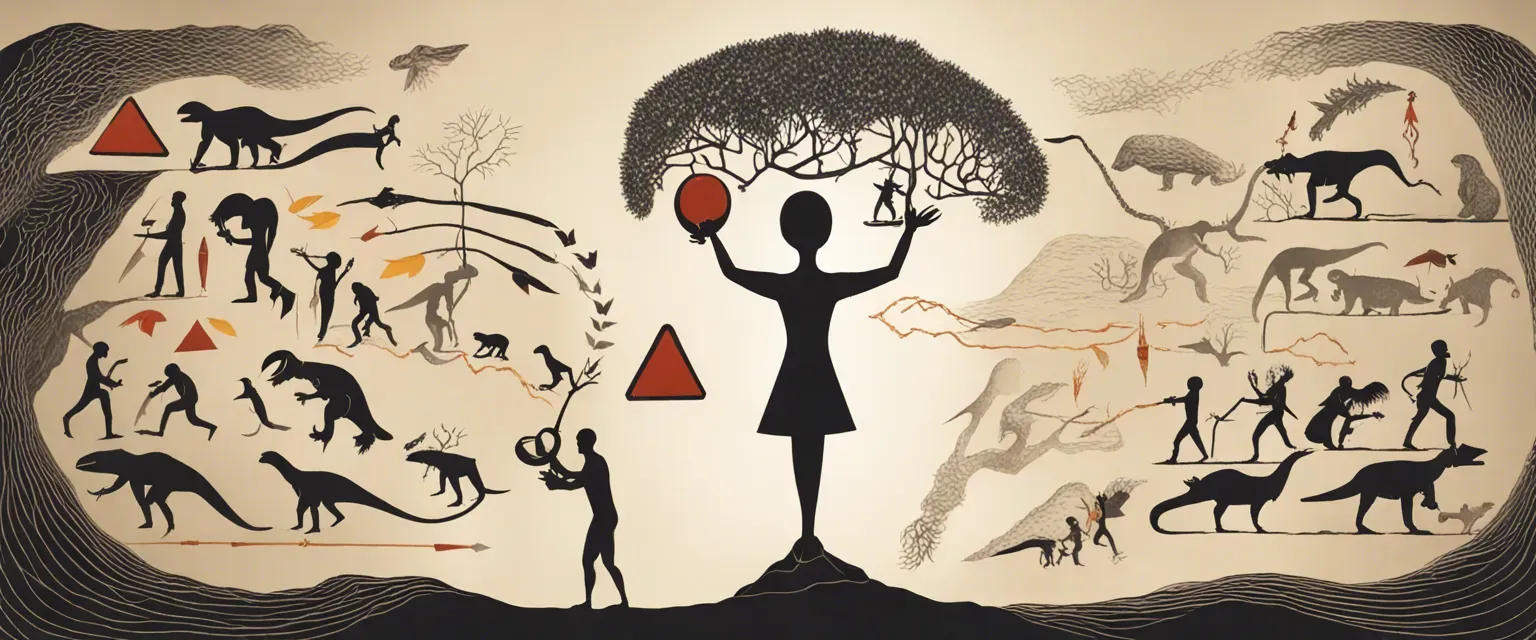——Why Evolution is True by Jerry A. Coyne & Why Buddhism Is True by Robert Wright
In the vast realm of human knowledge, the pursuit of truth takes various forms. From the scientific exploration of the natural world to introspective contemplation on the nature of existence, different disciplines offer distinct lenses through which truth can be perceived. In this comparative study, we delve into two seemingly disparate realms of understanding: biology and philosophy. With Jerry A. Coyne’s “Why Evolution is True” and Robert Wright’s “Why Buddhism Is True” as our guiding texts, we embark on a journey to explore the potential convergence between these worldviews.
Coyne’s thought-provoking work, “Why Evolution is True,” is a testament to the power of scientific reasoning and evidence-based reasoning. Drawing from a rich tapestry of empirical research, Coyne compellingly argues for the veracity of evolutionary theory. His exploration of various lines of evidence, such as the fossil record, genetic inheritance, and observed natural selection, presents a strong case for the truthfulness of evolution. By meticulously dismantling the misguided criticisms and misconceptions surrounding this theory, Coyne paves the way for a deep appreciation of the natural world as a product of an intricate, interconnected web of evolutionary processes. At its core, “Why Evolution is True” champions the idea that nature’s complexity and diversity can be best understood through the lens of evolutionary biology.
In stark contrast to Coyne’s scientific approach, Robert Wright invites us to embark on a contemplative journey through his book “Why Buddhism Is True.” Rooted in ancient Eastern wisdom, Buddhism offers a philosophical framework that seeks to uncover the ultimate truths about the human condition. Wright, drawing from both scientific and philosophical perspectives, cunningly argues that Buddhism’s core principles align with modern evolutionary psychology and cognitive science. By exploring concepts such as mindfulness, meditation, and the cognitive biases that shape our perception of reality, Wright invites us to question our fundamental assumptions about selfhood and the nature of suffering. His work challenges us to view Buddhism not merely as a religious or spiritual practice but as a potential vehicle for understanding and navigating the intricacies of our human experience.
While the subject matters of these two books might initially seem incompatible, they share intriguing parallels. Both Coyne and Wright delve into the depths of what it means to comprehend truth, albeit through different lenses. Coyne explores the external realm of the physical world, where intricate biological processes unite in the grand tapestry of evolution. Wright delves into the internal domain of human experience, seeking insights into the truths embedded within our consciousness. As we embark on this comparative study, we are compelled to scrutinize the potential intersections and divergence between scientific reasoning and philosophical contemplation, as they strive to uncover the essence of truth in different realms.
Exploring the interplay between biological evolution and spiritual enlightenment, we aim to uncover unforeseen connections and synergies between these two texts. Through critically analyzing the arguments presented by Coyne and Wright, we seek to discern possible areas of harmony where scientific understanding and philosophical inquiry can find common ground. Are these seemingly distinct avenues of exploration merely divergent approaches to understanding the human condition? Or do they converge towards a more complete comprehension of our existence? By investigating the merits and limitations of both perspectives, we aspire to shed light on the intricate tapestry of truth as it emerges from the pages of “Why Evolution is True” and “Why Buddhism Is True.”
Brief Summary of Two Books
Why Evolution is True by Jerry A. Coyne
Why Evolution is True” by Jerry A. Coyne is a comprehensive and accessible exploration of the evidence and principles supporting the theory of evolution. The book presents a compelling argument for the validity of evolution by examining various aspects of the natural world, including fossil records, biogeography, embryology, and genetics. Coyne addresses common misconceptions and misconstrued arguments against evolution, explaining how the theory has withstood rigorous scientific scrutiny and is accepted as the foundation of modern biology. Through clear explanations and engaging examples, Coyne highlights the overwhelming evidence that supports evolution and dispels the claims made by those who deny its validity. This book serves as an informative and persuasive guide, offering readers a deeper understanding of how evolution shapes and explains the natural world.
Why Buddhism Is True by Robert Wright
“Why Buddhism is True” by Robert Wright is a thought-provoking exploration that combines science, philosophy, and Buddhist teachings to argue for the truth of Buddhism in the modern world. The book aims to provide a rational and scientific framework for understanding the core tenets of Buddhism while examining their resonance with contemporary scientific discoveries.
Wright begins by delving into the human mind and its evolutionary origins, highlighting how natural selection has shaped the mind’s biases, emotions, and desires. He argues that these mental structures often lead to suffering and dissatisfaction, a central concept in Buddhism.
Drawing upon current research in psychology and neuroscience, Wright explores how Buddhist practices like meditation can modify the mind, reduce suffering, and enhance well-being. By training the mind to cultivate awareness, mindfulness, and compassion, individuals can potentially overcome the inherent flaws of their evolved nature and achieve a more enlightened state.
The author also examines key Buddhist concepts such as non-self and impermanence, offering scientific perspectives that demonstrate their plausibility. He argues that these concepts align closely with evolutionary theories and modern scientific insights, adding credibility to their validity and applicability.
Furthermore, Wright skillfully explores the Buddha’s teachings on desire, attachment, and the illusory nature of reality. He suggests that our desires are often insatiable and can lead to suffering, but by acknowledging their transient nature and practicing non-attachment, we can find greater peace and contentment.
Overall, “Why Buddhism is True” presents a comprehensive argument for the compatibility of Buddhism with contemporary science, offering a compelling case for its relevance in understanding the human mind, emotions, and well-being. By utilizing an evidence-based approach, Robert Wright seeks to bridge the gap between ancient wisdom and modern understanding, inviting readers to consider the transformative potential of Buddhist philosophy and practice in their own lives.
Comparison between Two Books

Similarities in Mysteries Of Our Body
While I cannot provide a direct parallel between “Why Evolution is True” by Jerry A. Coyne and “Why Buddhism Is True” by Robert Wright, I can identify some similarities related to the overarching theme of understanding mysteries in “Mysteries Of Our Body.” Both books explore different aspects of human existence and aim to shed light on certain enigmas. Here are some common elements that can be found:
1. Inquiry into the nature of existence: “Why Evolution is True” investigates the scientific evidence supporting the theory of evolution, unraveling the mystery of how human beings have evolved over time. On the other hand, “Why Buddhism Is True” delves into the teachings of Buddhism and explores the nature of reality, consciousness, and the human mind. In both cases, the authors are driven by an inherent curiosity about the truths of our existence.
2. Interdisciplinary approach: Both books draw upon a range of disciplines to provide a comprehensive understanding. “Why Evolution is True” combines biology, paleontology, and genetics, while “Why Buddhism Is True” incorporates elements of psychology, philosophy, and neuroscience. Similarly, “Mysteries Of Our Body” likely explores various scientific fields to unveil the secrets of our physical being.
3. Emphasis on empirical evidence: Both authors prioritize empirical evidence in their quests for truth. Coyne uses scientific studies, fossil records, and genetic data to support the theory of evolution, leaving little room for subjective interpretation. Wright also relies on scientific research and psychological experiments to back his claims about the benefits of meditation and mindfulness. “Mysteries Of Our Body” may follow a similar evidence-based approach when discussing puzzling phenomenon related to the human body.
4. Challenging conventional wisdom: Coyne challenges creationist beliefs and advocates for the acceptance of evolution as a fact. Similarly, Wright challenges conventional views on the nature of self and personal identity, proposing alternative perspectives through the lens of Buddhism. “Mysteries Of Our Body” might explore unconventional or lesser-known theories to provide fresh insights into physiological phenomena that are yet to be fully understood.
It is worth noting that these commonalities are an inference, as “Mysteries Of Our Body” is not an explicitly mentioned book. However, by examining the themes and approaches of the two provided texts, we can draw some conjectural parallels related to the exploration of mysteries concerning human existence.
Divergences in Mysteries Of Our Body
“Why Evolution is True” by Jerry A. Coyne and “Why Buddhism Is True” by Robert Wright are two distinct books that explore different topics from a scientific and philosophical perspective. While both books endeavor to shed light on various facets of human existence, they diverge in how they approach the concept of mysteries surrounding our bodies.
In “Why Evolution is True,” Coyne focuses on presenting evidence and explanations for the theory of evolution. The book delves into the vast array of scientific studies, ranging from fossil records to genetic research, to support the idea that evolution is the driving force behind the diversity of life on Earth. Coyne analyzes various aspects of the human body, such as the similarity of DNA across species, the existence of vestigial organs, and the development of complex structures like the eye. His argument revolves around the idea that these observations strongly suggest that our bodies have evolved over time, dismissing the need for divine intervention or supernatural explanations.
On the other hand, “Why Buddhism Is True” by Robert Wright takes a philosophical approach and examines the teachings of Buddhism through the lens of modern psychology and evolutionary biology. The book delves into the nature of human suffering and explores how the practices advocated by Buddhism can help alleviate it. While Wright acknowledges the existence of mysteries surrounding our bodies, such as the intricacies of consciousness, perception, and emotions, he does not attempt to solve them through scientific explanations. Instead, he emphasizes the importance of understanding the function and adaptive value of these physiological processes in terms of evolutionary biology.
The main divergence regarding the mysteries of our bodies between these two books lies in their approach: Coyne seeks to demystify these mysteries using scientific evidence and evolutionary theory, whereas Wright approaches them through a lens of meditation, mindfulness, and Buddhist philosophy. Coyne aims to provide empirical evidence to support the idea that evolutionary processes have shaped our bodies over millions of years, while Wright aims to offer a perspective that reconciles the human experience with the principles of Buddhism and evolutionary biology.
In summary, while both “Why Evolution is True” and “Why Buddhism Is True” acknowledge the existence of mysteries surrounding our bodies, the former delves into scientific evidence to explain these mysteries, while the latter explores them through the lens of Buddhist philosophy and meditation practices.

Conclusion
The choice between “Why Evolution is True” by Jerry A. Coyne and “Why Buddhism Is True” by Robert Wright ultimately depends on your personal interests and preferences. Both books offer fascinating insights into different aspects of human understanding and philosophy, but they explore different subjects.
Jerry A. Coyne’s “Why Evolution is True” provides a comprehensive overview of the theory of evolution and presents evidence from various scientific disciplines to support its validity. If you are interested in understanding the scientific framework behind evolution and how it shapes our understanding of the natural world, this book would be a great choice.
On the other hand, Robert Wright’s “Why Buddhism Is True” explores the intersection of psychology and Buddhism, examining how Buddhist teachings align with modern scientific findings. This book delves into topics such as meditation, mindfulness, and the Buddhist concept of suffering. If you are intrigued by the potential benefits of mindfulness and want to explore the philosophical and psychological aspects of Buddhism, this book may be more suitable for you.
Ultimately, it is worth considering your own interests and which topic aligns more with your own curiosity. If you are more scientifically inclined and want to explore the evidence for evolution, “Why Evolution is True” would be the better choice. However, if you are interested in psychology, mindfulness, and exploring the connections between Buddhism and modern science, “Why Buddhism Is True” could be the more worthy read for you.



